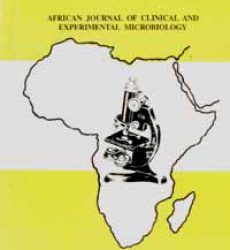*Odjadjare, E. E. O., and Ebowemen, M. J.
Environmental, Public Health and Bioresource Microbiology Research Group (EPHBIOMREG), Department of Biological Sciences, Benson Idahosa University, P.M.B. 1100 Benin City, Edo State, Nigeria
*Correspondence to: eodjadjare@biu.edu.ng
Abstract:
Background: Bacteria from abattoir wastes are often linked to livestock carcasses previously exposed to continuous antimicrobial use and misuse; thereby creating opportunity for community spread of multidrug resistant (MDR) strains such as Pseudomonas spp. The aim of this study was to investigate the antibiogram of Pseudomonas isolates and bacteriological quality of an abattoir effluent in lieu of its potential public health impact.
Methodology: Water samples were collected weekly for six weeks from discharge point (DP) of the abattoir effluent, effluent receiving canal confluence point (CP), and 500 m upstream (US) and 500 m downstream (DS) from points where CP made contact with the Ikpoba River, Benin City, Nigeria. Bacteria spp. were isolated, enumerated (heterotrophic bacterial plate, coliform, Escherichia coli and Pseudomonas counts) and identified using standard microbiological techniques. Identity of Pseudomonas isolates was confirmed by PCR while antibiogram of selected isolates was evaluated and interpreted according to the disk diffusion method of the Clinical and Laboratory Standards Institute (CLSI).
Results: Heterotrophic bacteria plate counts (HPC) varied from 1.1×103 ± 0.28 CFU/ml to 1.95×106 ± 0.48 CFU/ml; total coliform counts ranged between 0.0 and 1.2×106 ± 0.28 CFU/ml while mean E. coli count varied from 0.0 to 4.9×105 ± 0.49 CFU/ml, and Pseudomonas counts were between 0.0 to 1.4×103 CFU/ml. The selected strains of Pseudomonas spp (n=50) showed resistance to oxacillin (100%), vancomycin (52%), tetracycline (50%), gentamycin (26%) and ceftriaxone (20%), while they were sensitive to ceftazidime (82%), ofloxacin (80%) and amikacin (74%). MDR phenotype was observed in 9 (18%) of the test isolates.
Conclusion: The study revealed that untreated abattoir effluent was a considerable source of MDR Pseudomonas spp. among other bacteriological pollutants (e.g. HPC, coliform and E. coli) that could compromise the quality of the receiving river in lieu of public health concerns of riverside communities that depend on this vital water resource for their subsistence.
Keywords: Pseudomonas, MDR, antibiogram, abattoir effluent, public health
Received March 16, 2020; Revised April 24, 2020; Accepted April 26, 2020
Copyright 2020 AJCEM Open Access. This article is licensed and distributed under the terms of the Creative Commons Attrition 4.0 International License <a rel=”license” href=”http://creativecommons.org/licenses/by/4.0/”, which permits unrestricted use, distribution and reproduction in any medium, provided credit is given to the original author(s) and the source.
Antibiogramme des isolats de Pseudomonas et impact potentiel sur la santé publique d’un effluent d’abattoir à Benin City, Nigeria
*Odjadjare, E. E. O., et Ebowemen, M. J.
Groupe de recherche sur l’environnement, la santé publique et la microbiologie des bioressources (EPHBIOMREG), Département des sciences biologiques, Université Benson Idahosa, P.M.B. 1100 Benin City, Edo State, Nigeria Continue reading “Antibiogram of Pseudomonas isolates and potential public health impact of an abattoir effluent in Benin City, Nigeria”

